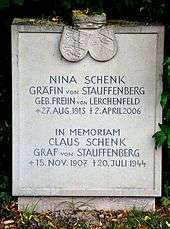Nina Schenk Gräfin von Stauffenberg
Elisabeth Magdalena "Nina" Schenk Gräfin von Stauffenberg (27 August 1913 – 2 April 2006) was the wife of Colonel Claus Schenk Graf von Stauffenberg, the leader of the failed plot to assassinate Adolf Hitler on 20 July 1944. Following the plot's failure, she was arrested and imprisoned, during which time she delivered her youngest child.
Nina Schenk Gräfin von Stauffenberg | |
|---|---|
| Born | Magdalena Freiin von Lerchenfeld August 27, 1913 |
| Died | April 2, 2006 (aged 92) |
| Nationality | German |
| Known for | Wife of Claus von Stauffenberg, Nazi test pilot and resistance supporter |
| Title | Countess |
| Children | Berthold Maria Schenk Graf von Stauffenberg Franz-Ludwig Schenk Graf von Stauffenberg Konstanze von Schulthess |
Biography
Born Magdalena von Lerchenfeld in Kowno, Imperial Russia (now Kaunas, Lithuania), she was known by her nickname "Nina". Her father was the Bavarian nobleman and politician General Consul Gustav Freiherr von Lerchenfeld (1871–1944) and her mother Anna Freiin von Stackelberg (1880–1945), a Baltic-German noblewoman, who in turn was great-granddaughter of Johan Mauritz von Haucke, which makes Nina third cousin of Prince Philip, Duke of Edinburgh.
Nina von Lerchenfeld and Claus Schenk Graf von Stauffenberg were married on 26 September 1933 in Bamberg, Bavaria, making Nina the Countess (Gräfin) von Stauffenberg. Although Nina's and Claus von Stauffenberg's mothers were both Lutherans, the couple's children were raised as Roman Catholics, in accordance with the wishes of Stauffenberg's father.
The marriage produced five children:
- Berthold Maria Schenk Graf von Stauffenberg (born 1934).
- Heimeran Schenk Graf von Stauffenberg (born 9 July 1936 in Bamberg, Bavaria), unmarried and without issue.
- Franz-Ludwig Schenk Graf von Stauffenberg (born 1938).
- Valerie Ida Huberta Karoline Anna Maria Schenk Gräfin von Stauffenberg (born 15 November 1940 in Bamberg; died 4 June 1966 in Munich, Bavaria of leukemia), married Heino von L'Estocq (born 6 April 1935 in Potsdam, Brandenburg) on 4 April 1964.
- Konstanze Schenk Gräfin von Stauffenberg (born 27 January 1945 in Frankfurt an der Oder, Brandenburg), married Dietrich von Schultheiss-Rechberg (born 13 October 1937 in Zurich, Switzerland) on 8 April 1967.
After her husband's failed attempt to assassinate Hitler (he was summarily executed the following evening), the Countess von Stauffenberg was arrested by the Gestapo and taken into custody under the ancient Sippenhaft law reinstated by the Nazi government. Her five children were placed in an orphanage in Bad Sachsa, Lower Saxony, under the surname of Meister. At the time of her husband's death, Stauffenberg was pregnant and in January 1945 she gave birth to her fifth child, Konstanze, while imprisoned in a Nazi maternity center in Frankfurt an der Oder. That same year, her own mother, Anna, died in a Russian detention camp.

By the end of the Second World War, Stauffenberg had been moved to the Italian province of South Tyrol. There she was held as a hostage in return for the redemption of Nazi property. After the war, she was reunited with her family at the Stauffenberg family seat in Lautlingen, Baden-Württemberg. She died in Kirchlauter, near Bamberg, Bavaria, on 2 April 2006 at the age of 92.[1][2]
The biography Nina Schenk Gräfin von Stauffenberg - Ein Porträt by Konstanze von Schulthess-Rechberg, Stauffenberg's youngest daughter, was published in 2008 (Munich: Pendo Verlag, ISBN 3-85842-652-0 / ISBN 978-3-85842-652-9).
Notes
- ^ Regarding personal names: Gräfin was a title before 1919, but now is regarded as part of the surname. It is translated as Countess. Before the August 1919 abolition of nobility as a legal class, titles preceded the full name when given (Graf Helmuth James von Moltke). Since 1919, these titles, along with any nobiliary prefix (von, zu, etc.), can be used, but are regarded as a dependent part of the surname, and thus come after any given names (Helmuth James Graf von Moltke). Titles and all dependent parts of surnames are ignored in alphabetical sorting. The masculine form is Graf.
- ^ Regarding personal names: Freiin was a title before 1919, but now is regarded as part of the surname. It is translated as Baroness. Before the August 1919 abolition of nobility as a legal class, titles preceded the full name when given (Graf Helmuth James von Moltke). Since 1919, these titles, along with any nobiliary prefix (von, zu, etc.), can be used, but are regarded as a dependent part of the surname, and thus come after any given names (Helmuth James Graf von Moltke). Titles and all dependent parts of surnames are ignored in alphabetical sorting. The title is for unmarried daughters of a Freiherr.
References
- "Countess von Stauffenberg". The Telegraph. 5 April 2006. Retrieved 23 June 2018.
- "Stauffenberg-Enkelin feiert Hochzeit in Kirchlauter". Infranken. 21 September 2014. Retrieved 23 June 2018.
Sources
- (in German) Zeller, Eberhard (1994). Oberst Claus Graf Stauffenberg. Ein Lebensbild. Paderborn: Ferdinand Schöningh. ISBN 3-506-79770-0.
- (in German) Steffahn, Harald (2002). Stauffenberg. Hamburg: Rowohlt Taschenbuch Verlag Reinbek. ISBN 3-499-50520-7.
- (in German) Ueberschär, Gerd R. (2004). Stauffenberg. Der 20. Juli 1944. Frankfurt am Main: S. Fischer Verlag. ISBN 3-10-086003-9.
- (in German) Hassel, Fey von, "Niemals sich beugen". dtv.
- (in German) Meding, Dorothee von (1997). Mit dem Mut des Herzens – Die Frauen des 20. Juli. btb Verlag. ISBN 3-442-72171-7.
External links
- (in English) Nina von Stauffenberg, The Times, 2006-04-11 (retrieved 2009-07-18).
- (in German) "Stauffenberg-Witwe gestorben", Netzzeitung, 4. April 2006.
- (in German) Genealogisches Handbuch der estländischen Ritterschaft